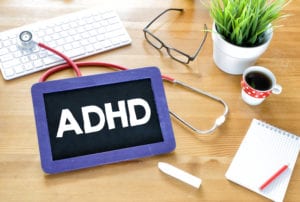Written by Joyce Smith, BS. In-School Neurofeedback Training for elementary school students with ADHD were reported to have fewer ADHD symptoms 6 months after the intervention.
 Attention-deficit/hyperactivity disorder (ADHD) is a neurodevelopmental brain disorder that includes a combination of persistent problems, such as difficulty sustaining attention, hyperactivity and impulsive behavior. Its prevalence in 9.5% of 4-17 year-olds in the United States and affects academic and social outcomes of affected children. Viable treatment options such as medication and behavior therapy have limitations and highlight the need for effective alternative treatments that are both affordable and effective.
Attention-deficit/hyperactivity disorder (ADHD) is a neurodevelopmental brain disorder that includes a combination of persistent problems, such as difficulty sustaining attention, hyperactivity and impulsive behavior. Its prevalence in 9.5% of 4-17 year-olds in the United States and affects academic and social outcomes of affected children. Viable treatment options such as medication and behavior therapy have limitations and highlight the need for effective alternative treatments that are both affordable and effective.
Studies have found increased theta wave activity and increased theta:beta ratios in the frontal cortex 1 of children with ADHD where beta waves are associated with sustained attention and thinking and theta waves are prevalent when drowsy or daydreaming 2,3. Neurofeedback trains users to monitor and change their brainwave patterns, leading to behavioral changes 4 which according to some studies can sustain improved attention, behavior and cognition 5 for as long as 6 months to two years post treatment. Cognitive training (CT) in contrast, uses specifically designed exercises and ongoing feedback to reinforce correct behavioral responses.
Steiner and team conducted in 2009 the first in-school randomized, controlled trial 6 comparing neurofeedback and CT under controlled conditions. They hypothesized that participants receiving neurofeedback would maintain improvements in attention and executive functioning compared with control or CT conditions and that medication dosage would remain stable.
The research team randomly assigned 104 children in second and fourth grades with ADHD into three groups to receive in-school neurofeedback (Play Attention, Unique Logic and Technology Inc), CT (Captain’s Log, Brain Train), or a control condition. Both neurofeedback and CT groups received three 45-minute intervention sessions each week in the classroom for a total of 40 sessions under the supervision of a research assistant.
Observations before and immediately after the interventions, reported previously by the investigators, showed significantly greater improvements in ADHD symptoms, including attention and executive functioning, in the neurofeedback group relative to the CT or control condition groups.
Six months post intervention, researchers found a similar pattern. Children who received neurofeedback maintained significant gains on all of the core ADHD subscales and executive functioning scales: the Conners 3–Parent Assessment Report for inattention (effect size [ES] = 0.34), executive functioning (ES = 0.25), and hyperactivity/impulsivity (ES = 0.23) and on the Behavior Rating Inventory of Executive Function Parent Form (BRIEF) subscales, including the global executive composite (ES = 0.31) compared to the children in CT and control condition groups.
Medication dosage was also sustained in the neurofeedback group while the CT and control groups required increased medication. Not all children in the neurofeedback group were on medication and the authors found that those on medication improved as much as the children who were not on medication.
Both neurofeedback and CT training systems are currently being used in school systems across the United States 7,8, lending credence to the importance of effective systematic studies. The authors hope for continued research to determine which interventions are associated with best treatment outcomes in cohorts of older children with ADHD.
Source: Steiner, Naomi J., Elizabeth C. Frenette, Kirsten M. Rene, Robert T. Brennan, and Ellen C. Perrin. “In-school neurofeedback training for ADHD: sustained improvements from a randomized control trial.” Pediatrics 133, no. 3 (2014): 483-492.
Posted August 30, 2019.
Joyce Smith, BS, is a degreed laboratory technologist. She received her bachelor of arts with a major in Chemistry and a minor in Biology from the University of Saskatchewan and her internship through the University of Saskatchewan College of Medicine and the Royal University Hospital in Saskatoon, Saskatchewan. She currently resides in Bloomingdale, IL.
References:
- Loo SK, Makeig S. Clinical utility of EEG in attention-deficit/hyperactivity disorder: a research update. Neurotherapeutics. 2012;9(3):569-587.
- Liechti MD, Valko L, Muller UC, et al. Diagnostic value of resting electroencephalogram in attention-deficit/hyperactivity disorder across the lifespan. Brain Topogr. 2013;26(1):135-151.
- Arns M, Conners CK, Kraemer HC. A decade of EEG Theta/Beta Ratio Research in ADHD: a meta-analysis. J Atten Disord. 2013;17(5):374-383.
- Heinrich H, Gevensleben H, Strehl U. Annotation: neurofeedback – train your brain to train behaviour. Journal of child psychology and psychiatry, and allied disciplines. 2007;48(1):3-16.
- Leins U, Goth G, Hinterberger T, Klinger C, Rumpf N, Strehl U. Neurofeedback for children with ADHD: a comparison of SCP and Theta/Beta protocols. Applied psychophysiology and biofeedback. 2007;32(2):73-88.
- Steiner NJ, Frenette EC, Rene KM, Brennan RT, Perrin EC. In-school neurofeedback training for ADHD: sustained improvements from a randomized control trial. Pediatrics. 2014;133(3):483-492.
- Attention P. www.playattention.com. Accessed August 22, 2013.
- Train B. www.braintrain.com. Accessed August 21, 2013.
